Looking for a better alternative to TimeCamp for your business?
You’re in the right place!
TimeCamp is a popular time tracking software that improves your work productivity, tracks remote workers and manages client invoicing.
However, it isn’t perfect.
It can be complicated to use and you’ll also have to deal with limited flexibility with its reports, among other things.
In this article, we’ll discuss the best alternatives to TimeCamp and how they can address your time tracking needs.
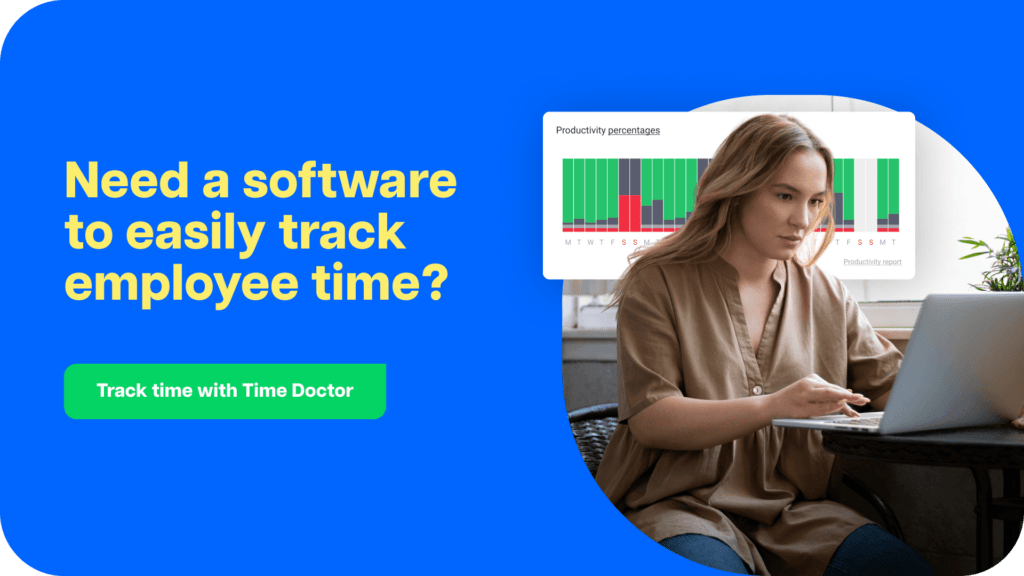
Table of Contents
- How to choose a time tracking software
- 5 criteria for choosing a time tracking app
- The 10 best alternatives to TimeCamp
Let’s get started.
How to choose a time tracking software
A powerful time tracking tool can improve employee productivity, analyze work progress, manage client billing and so much more.
However, choosing a time tracking app can be tough – especially when there are so many options available.
That’s why we’ve highlighted five things to consider when choosing a time tracking tool:
5 criteria for choosing a time tracking app
1. How accurately does the tool track time?
Every time tracker in the market monitors your employees’ working hours.
But how accurate and reliable is it?
Without reliable time tracking features, you won’t be able to:
- Check if your workers are wasting time on social media or non-work related activities and hold them accountable.
- See exactly how long a task took.
- Prevent employees from faking their timesheets.
- Show your clients how much time their projects took.
2. Can the tool help your employees from getting sidetracked?
It’s incredibly easy to get distracted at work.
Whether it’s tweets, online shopping or Youtube videos – there are tons of distractions online. Even the most focused employee gets distracted at some point!
However, these distractions are costly for your company.
When your employees are distracted during the workday, their productivity levels sink. They deliver less and the quality of that work suffers too.
Your time tracking tool must have features to help employees avoid distractions. Whether it’s blacklisting sites or showing pop-up reminders to get them back to work, it has to have some distraction management features.
3. Does it have advanced reporting capabilities?
Without powerful reports, a time tracker is practically useless!
Reports let you analyze how productively your employees spend their time. They should also let you calculate billable hours while invoicing a client.
Your time tracking tool should give you tons of different reports to analyze various aspects of your employee’s time usage, such as:
- Website and app usage.
- Poor time usage.
- Attendance records, and more.
For added flexibility, ensure that the software lets you export these reports in shareable formats like CSV files. This makes it easy to share these reports with your clients.
4. Can the tool allay your employees’ privacy concerns?
Many employees are apprehensive about any time tracking software.
Why?
They’re concerned that the tool may compromise their privacy and that they can be monitored during their off-work hours.
Hence, it’s essential to choose a time tracker that respects your employees’ privacy. Your employees must be able to start and stop the app when they want. They must also be aware of what data is being tracked and why.
Not doing this will not only alienate your workers – it might set you up for tons of legal problems in the long run.
5. Can the tool integrate with other software?
Time tracking apps aren’t the only tools in your tech stack, right?
You probably use project management apps, billing tools, team communication platforms and tons of other business software.
Why not look for time tracking apps that easily integrate with your other software? The benefits?
- You’ll be able to streamline your workflow and avoid manually transferring data between tools.
- Integrating your time tracker with these tools also helps you sync the time you spend on these apps in real-time.
The 10 best alternatives to TimeCamp
1. Time Doctor
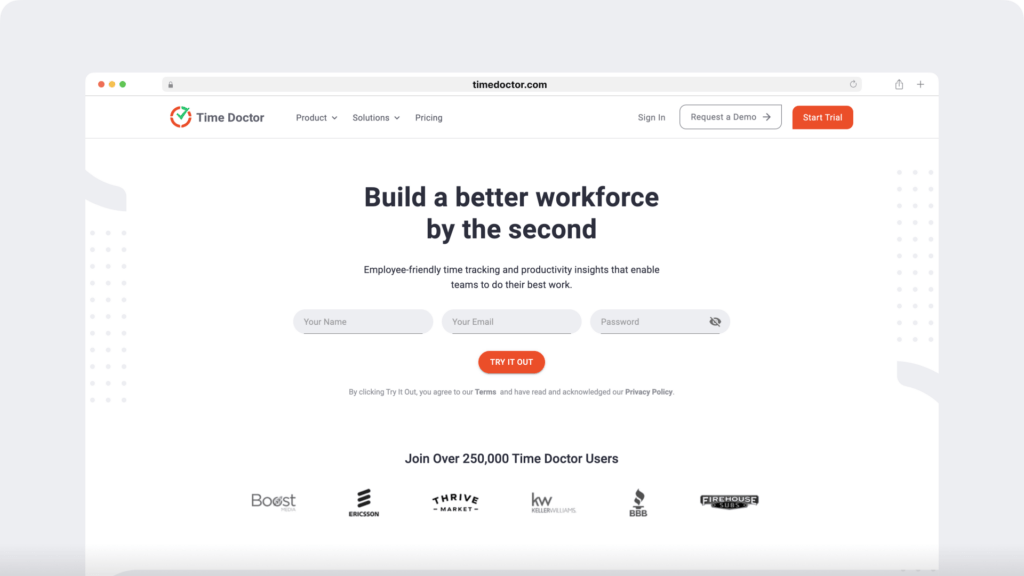
Time Doctor is a powerful time tracking and productivity monitoring software. With clients ranging from large corporations to SMBs like Firehouse Subs and Thrive Market – companies of all sizes use Time Doctor.
With Time Doctor, you can:
- Automatically track time spent by an employee on each task.
- Monitor the apps and websites they use during work hours.
- Identify unproductive employees and take measures to boost their productivity levels.
- Access tons of advanced reports for accurate client billing and employee monitoring.
- Seamlessly integrate with apps like Slack, GitHub, Google Apps, and many more.
Here’s a closer look at some of Time Doctor’s key features:
A) Simple and effective time tracking
If you want your employees to be productive, you can’t afford to have them waste time figuring out how to use your time tracking tool.
What you need is a powerful tool that’s easy to use.
With Time Doctor, that’s exactly what you get!
When starting work on a task, all they have to do is simply open Time Doctor and start the timer.
The app then runs in the background, tracking the time they’re spending on each task. Once they’re done working, they can stop the timer and the app stops tracking time.
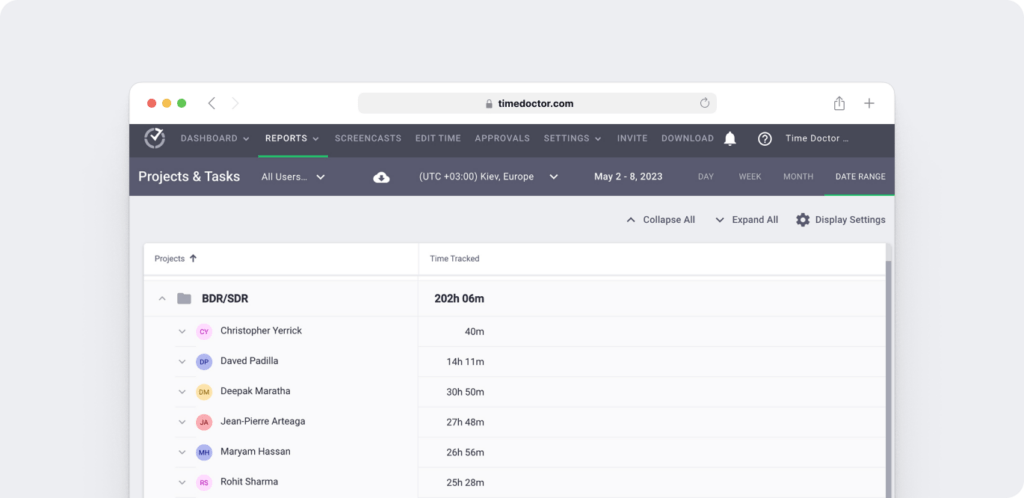
Why Allowing Employees to Start the Timer is More Accurate
Using a self start/stop timer doesn’t mean that your employees can game the system. In fact, by letting your employees start the timer manually, you’ll have more accurate tracking over their activities. Here’s how:
- Their web and app activity is tracked while the timer is running. Therefore, they can’t run the timer and watch Netflix at the same time.
- You can see how long people have worked on each task and exactly what they were during when they had voluntarily turned the timer on.
- Employees aren’t tracked during their off-hours – better for maintaining their privacy.
B) Distraction management
You can’t afford to let your employees waste time on distractions during work hours, right?
Fortunately, Time Doctor can help them stay focused!
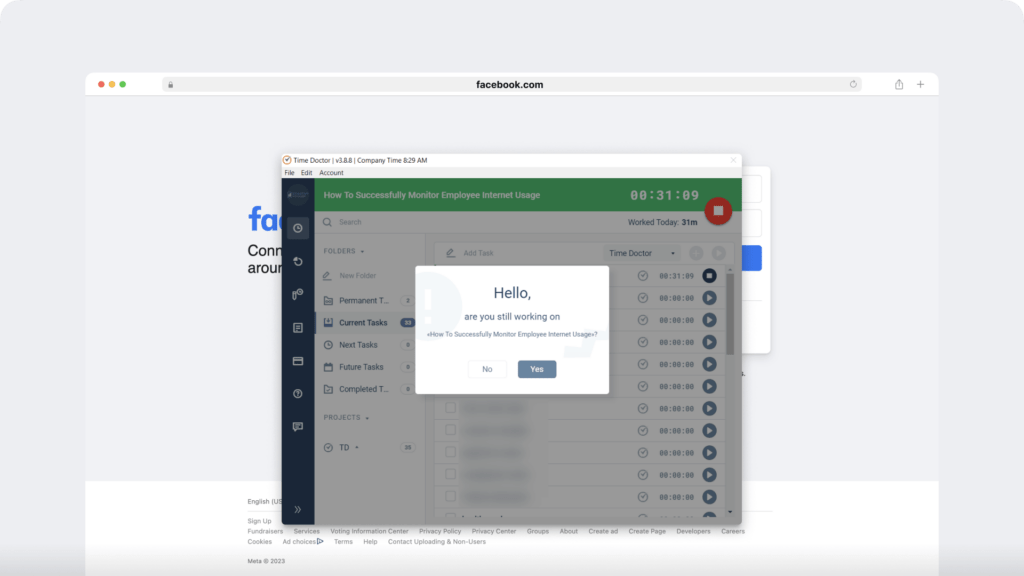
If an employee visits an unproductive website or if they’re inactive for three minutes during work hours, the tool automatically displays a pop-up asking if they’re still working or not. This nudge is usually enough to prompt them to get back to work.
For added customizability, you can customize which sites and apps are categorized as unproductive.
Time Doctor measures inactivity by monitoring mouse movements and clicks. If there’s no activity for three minutes, the tool will assume the employee is on a break.
Note – Time Doctor does not track which keys were pressed.
C) Web and app monitoring
Worried that your employees are accessing unproductive websites during work hours?
With Time Doctor, you won’t have to!
The tool automatically records your employees’ app and web usage while they’re working. You can see which websites and apps were accessed and for how long. It helps you analyze your employees’ time management and identify any distraction issues.
Note – You have the option to disable this feature for some or all employees.
D) Screenshot monitoring (optional)
Time Doctor gives you screenshot monitoring for added supervision over your employees. The software takes screenshots of an employee’s work screen at random intervals, which can then be used to review their productivity.
This feature is optional and can be enabled or disabled for each person in your company.
Note – An employee can choose to delete a particular screenshot if it mistakenly captured personal information.
E) Client access
Want to keep your clients in the loop while working on their projects?
You can give your clients access to your company’s Time Doctor account at no additional cost!
This allows them to view how their work is proceeding in real-time. You can even customize what data your clients access – like screenshots, timesheets and reports.
However, for privacy reasons, they can only see the data related to their own projects.
F) Payroll
Time Doctor’s Payroll feature makes it incredibly easy to pay your freelancers or employees based on their working hours or fixed salaries. It automatically calculates each employee’s pay and you can use your payment method of choice to pay them instantly.
While Time Doctor offers integrations with PayPal, Payoneer and Wise, formerly TransferWise, it lets you opt for any other payment method of your choice.
Time Doctor’s Payroll feature is also fully customizable. It lets you choose:
- The payment method – choose from the default payment methods or use other methods.
- The payroll period – choose from a list of default values or set a custom period.
- The rate type – set a fixed payment rate or opt for an hourly rate.
- The rate per hour.
- The currency – choose from a list of global currencies, and more.
G) Powerful reporting
Time Doctor automatically generates tons of advanced reports covering your employee’s time usage. Let’s look at its key reports:
1. Timesheet report
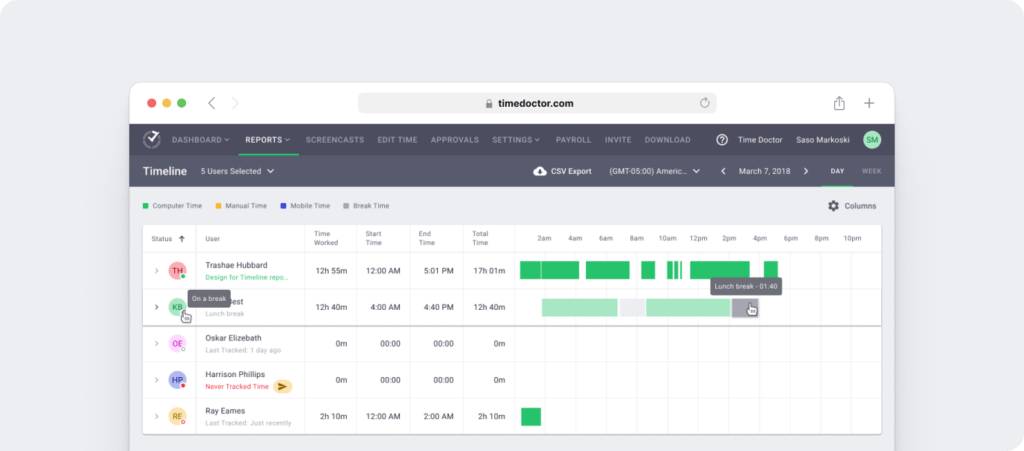
What does this show?
This report shows you the total hours worked by your staff per day over a given duration—like a week or a month.
Why is it useful?
You can use it to assess how many hours each worker spends on work on a daily, weekly or monthly basis.
2. Time use report
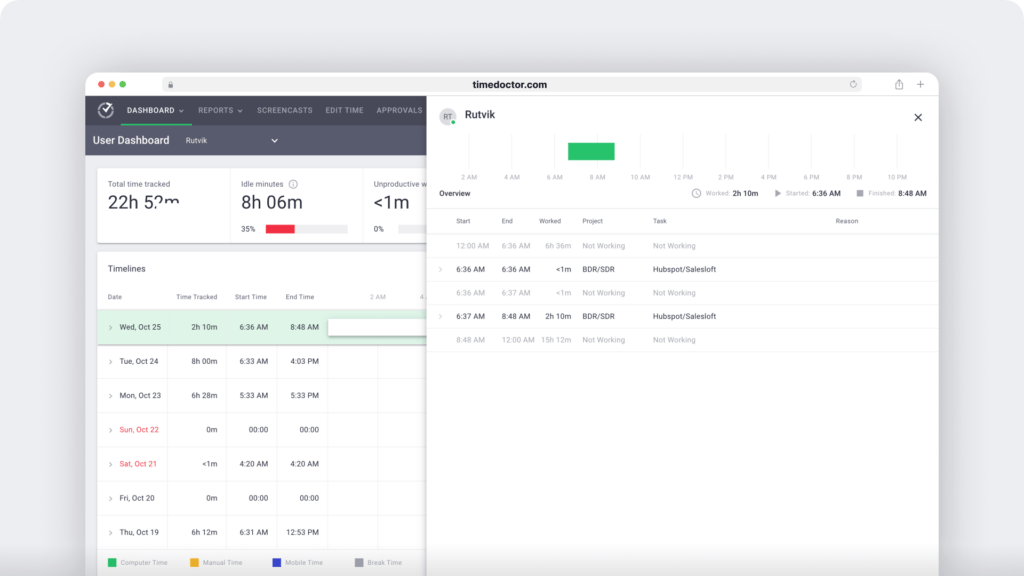
What does this show?
This report breaks down the time spent on all tasks by an employee over a given period.
Why is it useful?
You can use it to observe how employees utilize their time to complete their work. If a task is taking too long, you can step in to figure out the delay and act accordingly.
3. Projects report
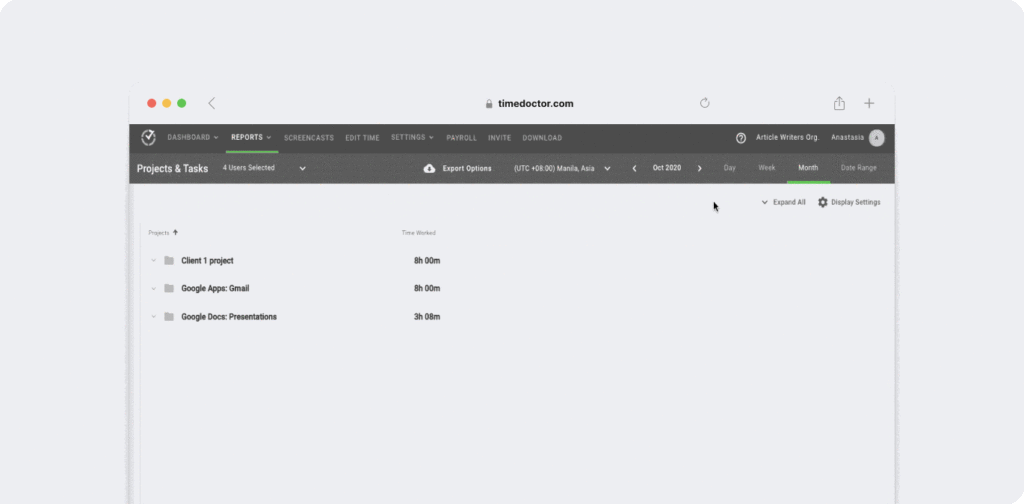
What does this show?
It breaks down the total hours spent by your staff on a project-wise basis. You can see who’s worked on each task and for how long.
Why is it useful?
The report can be used to track billable hours for a project. You can also use it to check if a project’s time estimates are being exceeded and work out estimates for future projects.
4. Web and app usage report
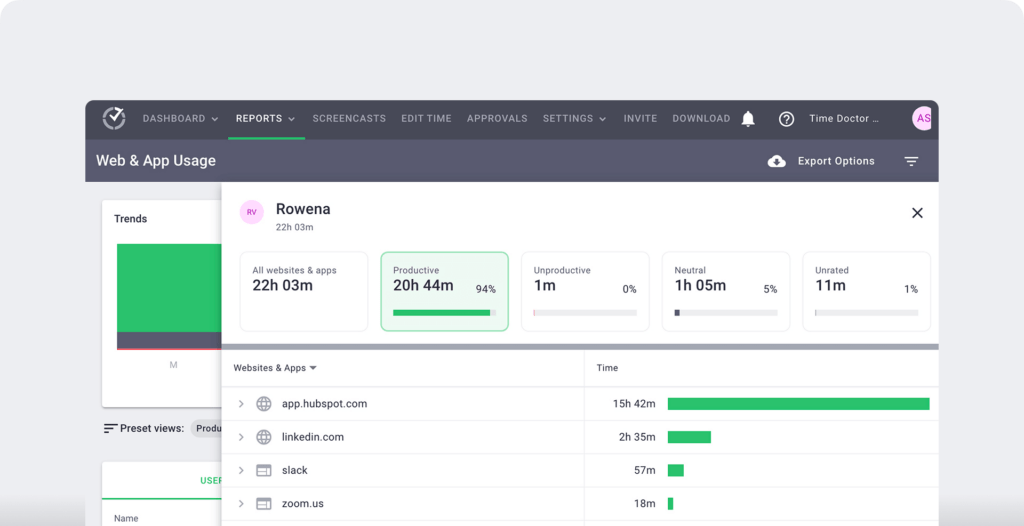
What does this show?
It displays the apps and websites used by an employee during their work hours, along with the duration they spent on each site/application.
Why is it useful?
You can use it to check if your employees are wasting their time on social media or other irrelevant websites and apps while their timer is running.
5. Timeline daily report
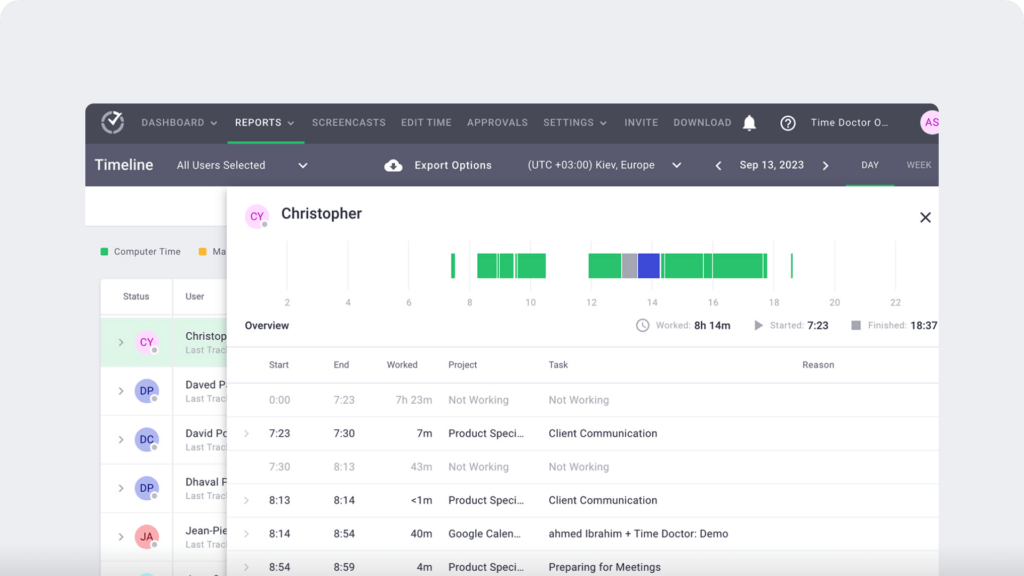
What does this show?
The report gives you a total breakdown of the time spent by an employee in a day, in chronological order. You can also see the tasks and projects they worked on and their duration.
Why is it useful?
Use it to monitor and evaluate unproductive employees. For example, you can check if your employee was taking too many breaks. By analyzing poor employee time management, you can offer them tips on increasing their productivity.
H) Integrations
Time Doctor seamlessly integrates with tons of different apps such as Google Apps, GitHub, Slack, Asana, ToDoist and ClickUp for added functionality.
It also has Zapier integrations with hundreds of applications like QuickBooks, Wunderlist and more.
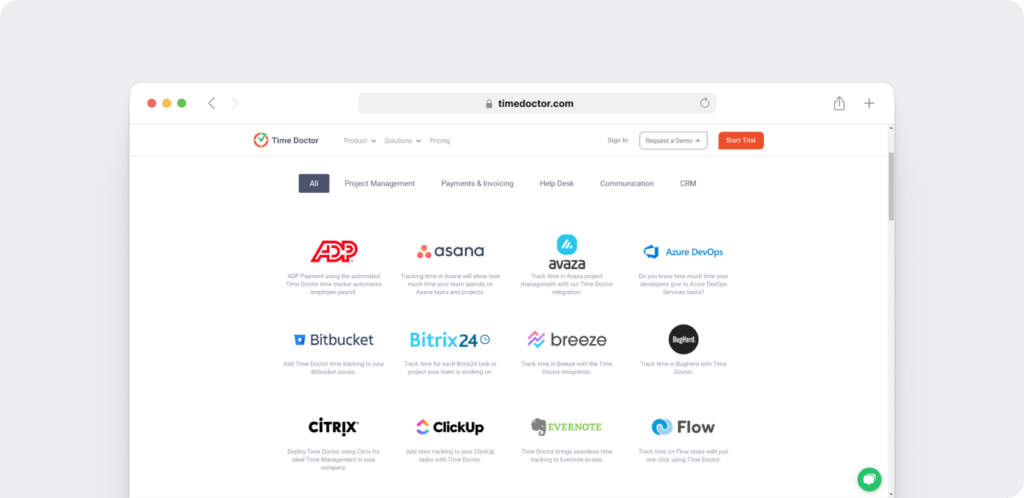
You can click here for the complete list of integrations.
Pros
- Accurate time tracking features.
- Powerful offline mode for monitoring employees without an internet connection.
- An integrated inactivity tracker.
- Strict privacy controls to protect your employees’ information.
- Simple and streamlined user-friendly interface.
- Cross-platform availability with support for Windows, Mac and Linux.
- iOS and Android apps for tracking time on the go.
- Reports can be easily exported as PDF, CSV or XLS.
- Seamlessly integrates with various applications – ranging from project management tools to CRMs.
Cons
- The tool may be more suitable for companies than freelancers.
- The Chrome extension isn’t as robust as the desktop and mobile versions.
Pricing
Time Doctor starts at $5.9/user per month and offers volume discounts. You can also sign up for a free 14-day trial without a credit card.
Customer ratings
- G2 – 4.4/5 (380+ user reviews)
- Capterra – 4.5/ 5 (520+ user reviews)
2. Clockify
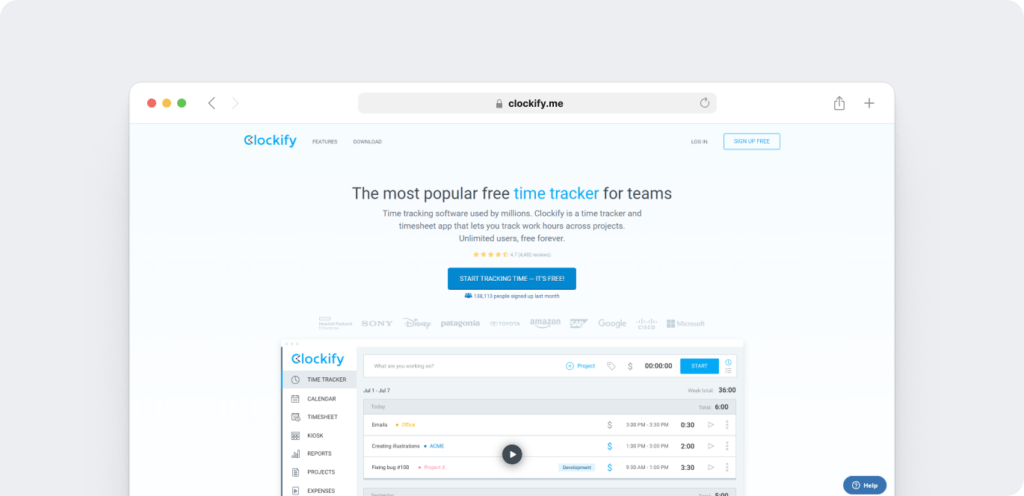
Clockify is a simple time tracking tool that lets you track work hours across projects. Its user-friendly interface and has made it a popular alternative to TimeCamp.
Key features
- Supports automated and manual time tracking.
- Simple, easy to use interface
- Generates detailed reports that can be exported as PDF, CSV or XLS.
- Tons of integrations with project management and productivity apps like ClickUp, Trello, Evernote.
Pros
- Has a desktop app for Windows, Mac and Linux.
- Powerful Mobile app for iOS and Android.
- Handy reports give you a detailed breakdown of data.
Cons
- Limited free version.
- Lacks distraction management features.
Pricing
Clockify has five pricing options you can choose from.
- Free: includes unlimited time tracking + reports + users + integrations.
- BASIC: $3.99/month-All FREE features
- STANDARD: $5.49/month -All BASIC features+ private time entries and time rounding features + company-branded reports and reminders.
- PRO: $7.99/month – includes STANDARD + project templates, alerts and bulk report features.
- ENTERPRISE: $11.99/month – includes PRO + improved security and dedicated customer support.
Customer ratings
- G2 – 4.5/5 (160+ reviews)
- Capterra – 4.7/ 5 (4800+ reviews)
3. RescueTime
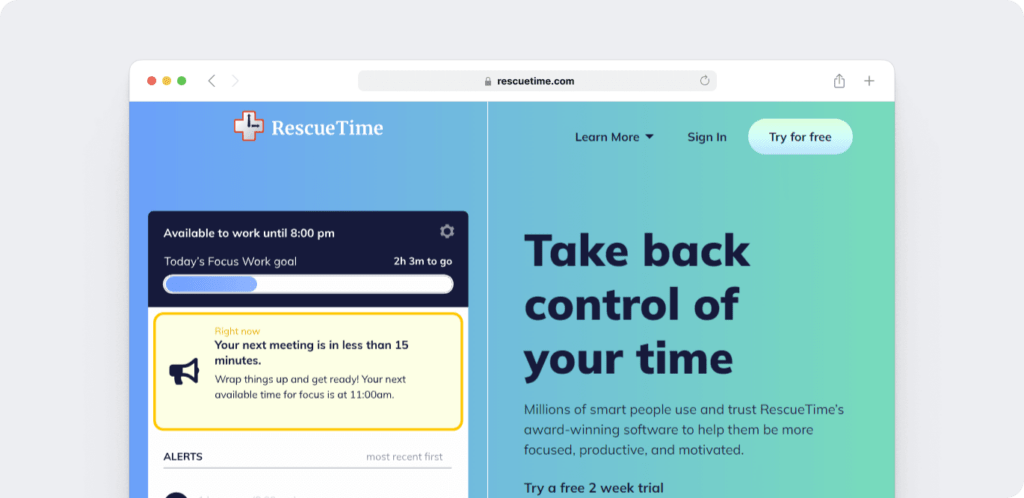
RescueTime is a web-based time tracking tool that also doubles up as a productivity app. The tool can identify poor time usage and help you take measures to boost your productivity.
Key features
- Automatic time tracking of websites and apps that you’ve accessed.
- Block distractions by blacklisting websites.
- Integrates with various project management and team communication apps such as GitHub and Slack.
Pros
- You can set productivity goals and alarms to increase your productivity.
- Easily block distracting sites and apps to improve your time management
- You can access detailed records of time spent.
Cons
- No task and project tracking capabilities.
- Lacks billing and invoicing support.
- Automatic time tracking is only available online – you can log offline time only through manual time entries.
Pricing
RescueTime offers two pricing schemes.
- RescueTime Lite: free version that includes basic tracking features.
- RescueTime: $12/month – aimed at individuals – includes real-time alerts and distraction blocker.
Customer ratings
- G2 Crowd – 4.1/5 (90 reviews)
- Capterra – 4.6/ 5 (130+ reviews)
Related article: RescueTime Review: Employee Tracking to Improve Team Productivity
4. Hubstaff
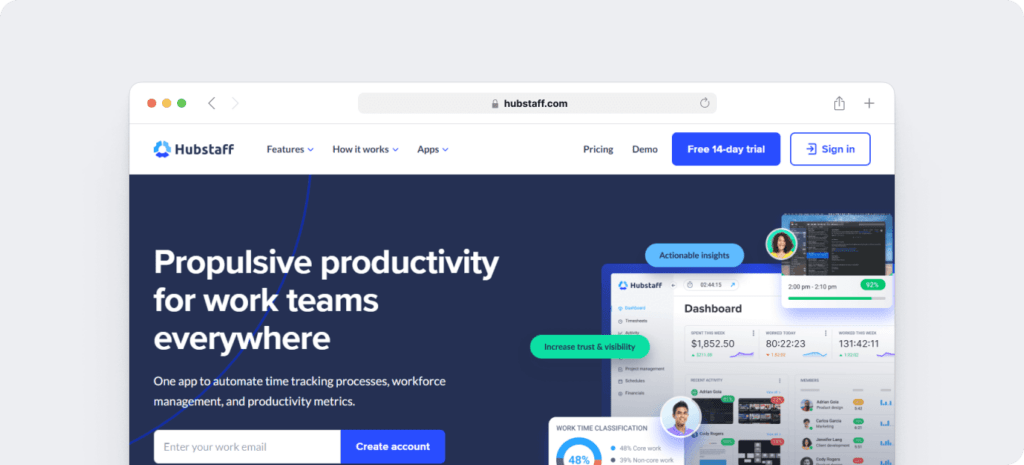
Hubstaff is a popular timesheet software that lets you track your employees while they work. With its simple and accurate time tracking features, you can determine how productive your team is.
Key features
- Highly accurate online timesheets.
- Advanced employee monitoring with screenshots.
- Built-in project and payroll management.
- Supports integrations with project management, invoicing, CRM and help desk apps.
Pros
- You can track time automatically or log in manually.
- You can enable screenshot monitoring of your employees’ work screen.
- The tool provides detailed reports with great visualizations and stats.
Cons
- Tricky to set up the software initially.
- The activity monitoring system can be difficult to use.
Pricing
Hubstaff is available in four pricing schemes:
- Starter-$4.99 2 users minimum Per Month
- Grow: $7.50 2 User Minimum Per Month – includes “Free” features + 1 integration
- Team: $10.00 2 User Minimum Per Month – includes “Graw” features + unlimited integrations + payroll.
- Enterprise: Custom pricing – includes “Premium” features.
Customer ratings
- G2 – 4.4/5 (700+ reviews)
- Capterra – 4.6/5 (1470+ reviews)
Related article: Hubstaff Review: Should You Really Monitor Your Employees?
5. Everhour
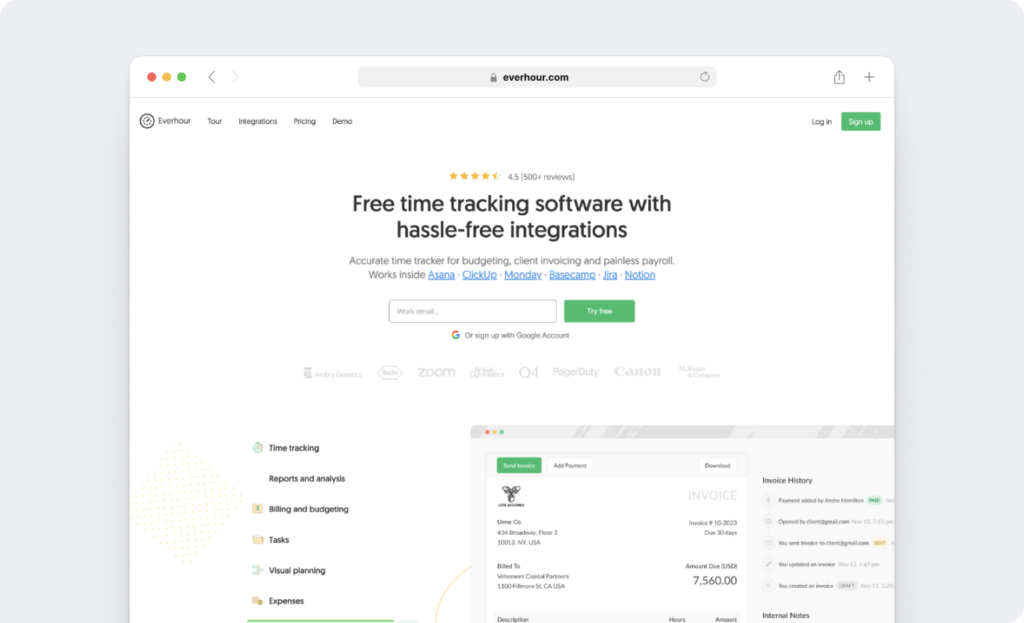
Everhour is a team-oriented time tracking software for project management and invoicing. Its built-in time tracking features make it a great choice to monitor remote workforces.
Key features
- Advanced time tracking features like setting reminders and project estimates.
- You can set up a time budget scheme for your projects. An email alert will be sent when you reach a specific percentage of the budget.
- Seamlessly integrates with various task management, invoicing and CRM apps. It also has native integrations with Asana, Trello, Basecamp, Jira and GitHub.
Pros
- Powerful browser add-ons for Chrome, Firefox and Safari.
- You can easily plan and allocate projects in accordance with your team’s schedule.
- The tool can create professional-looking invoices.
Cons
- Lacks distraction management features.
- Limited flexibility with reports.
- No mobile version to keep you productive on the go.
Pricing
Everhour offers two pricing plans. One is aimed at individuals while the other is aimed at teams and companies of any size.
- For individuals: free for up to 5 seats
- For teams: $8.50/month per user billed annually.
Customer ratings
- G2 Crowd – 4.7/5 (170 reviews)
- Capterra – 4.7/ 5 (410+ reviews)
6. Toggl
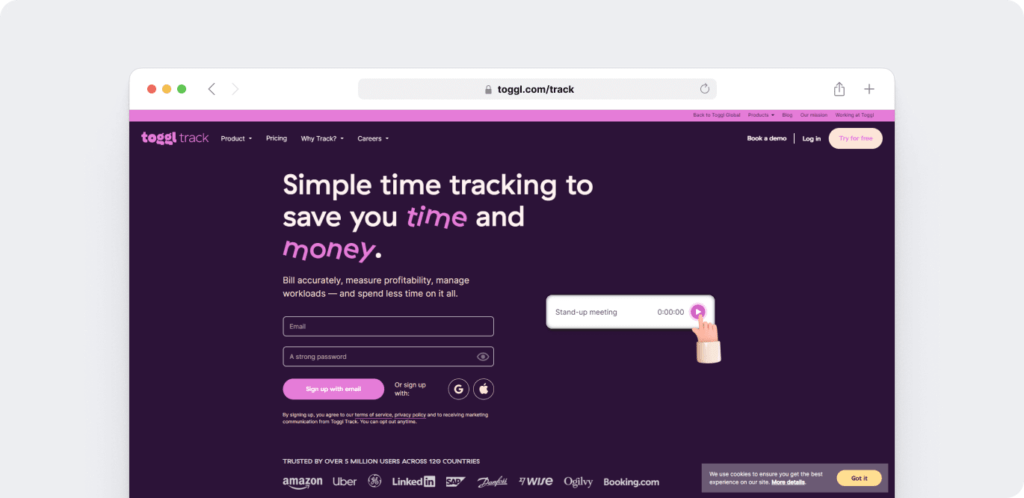
Toggl is an easy-to-use alternative to TimeCamp. It’s simple and flexible time tracking features make it a great choice for freelancers and small businesses.
Key features
- Powerful browser extension that tracks time for tons of different online tools.
- Automated timesheet management with real-time syncing across their mobile and desktop platforms.
- Detailed advanced reports that can be exported as PDF, XLS or CSV for easy sharing.
- Integrates with over 100 different tools ranging from project management apps to business software.
Pros
- Powerful yet simple time tracking tool.
- Zapier integration that connects Toggl with 1500+ apps.
- Excellent customer service.
Cons
- It doesn’t support web and app monitoring of your employees.
- Easy to create fake time entries.
- The base-level starter plan isn’t very feature-rich.
Pricing
Toggl offers four pricing plans depending on your requirements and team sizes.
- Free: Free for up to 5 users.
- Starter: $9/month per user billed annually – includes basic features like time tracking and reporting.
- Premium: $18/month per user billed annually – everything in Starter plan + team management and real-time features.
- Enterprise: custom pricing – everything in Premium plan + added customizations and expert support.
Customer ratings
- G2 Crowd – 4.6/5 (1560+ reviews)
- Capterra – 4.7/ 5 (2300+ reviews)
Related article: A Review of Toggl: Time Tracking Made Easy
7. Timely
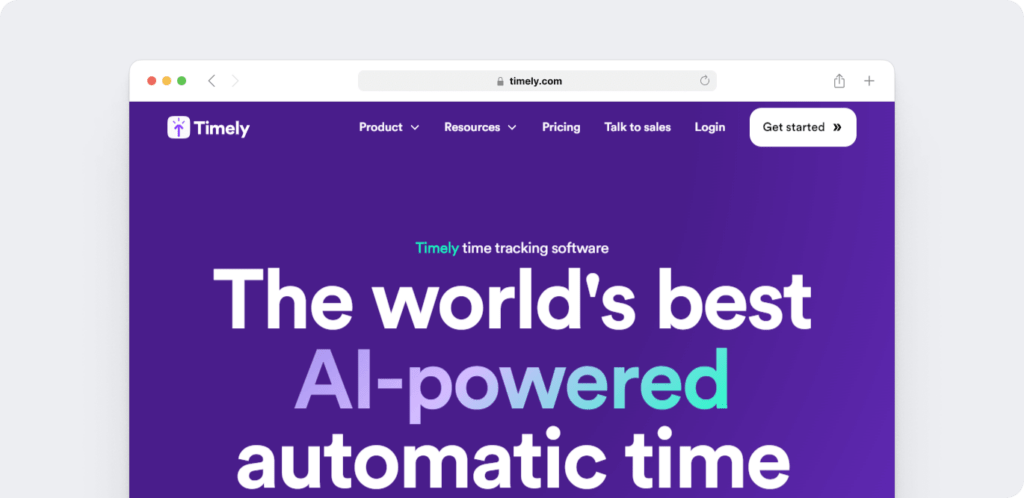
Timely is another powerful time tracking and productivity app. It tracks your activity across various platforms and categorizes them based on the files used, websites visited, and more.
Key features
- Automatic time tracking features that don’t require any manual inputs.
- Can easily capture billable activity.
- Timely integrates with tons of popular project management and team communication tools.
Pros
- Easy onboarding with a user-friendly interface.
- Cross-platform time tracking capabilities with support for Windows, Android, Mac and iOS.
- Powerful reports that can be exported as PDFs or XLS files.
Cons
- Fully automatic time tracking – thereby prone to several errors
- Lacks offline time tracking support.
- The dashboard can be confusing when there are tons of projects.
Pricing
Timely offers three main pricing plans.
- Starter: $9/month per user per month. Max 5 users
- Premium:$16/per user per month. Max 50 users
- Unlimited: $22/ per user per month. Unlimited users
Customer ratings
- G2 Crowd – 4.8/5 (400+ reviews)
- Capterra – 4.7/ 5 (210+ reviews)
8. My Hours
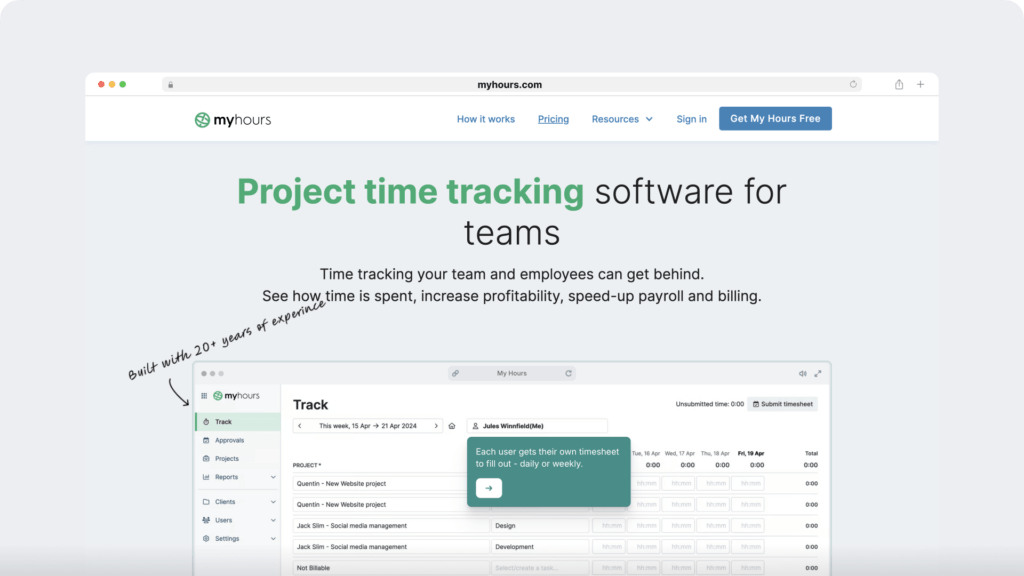
My Hours is a cloud-based time tracking software designed for small teams and freelancers. Track time on projects with tasks, generate insightful reports and send invoices to clients.
Key features
- Has simple time tracking with a low learning curve (web, iOS and Android).
- Generates insightful reports that can be exported and sent to clients instantly via email.
- Has customizable invoicing for fast and accurate billing.
- Allows you to manage billing rates (task, project and team member-based rate)
Pros
- Offers unlimited projects and tasks without changing the price.
- Extremely simple to use.
- Free iOS and Android app.
Cons
- Free version does not include invoices.
- Does not have a desktop app.
Pricing
- Free (does not include invoicing): Single users – Ideal for freelancers.
- Pro Trial: 14 day free trial.
- Pro (complete feature set): $8 per user per month
Customer ratings
- Capterra: 4.8/5 (972 reviews)
- G2: 4.6/5 (256 reviews)
9. TMetric
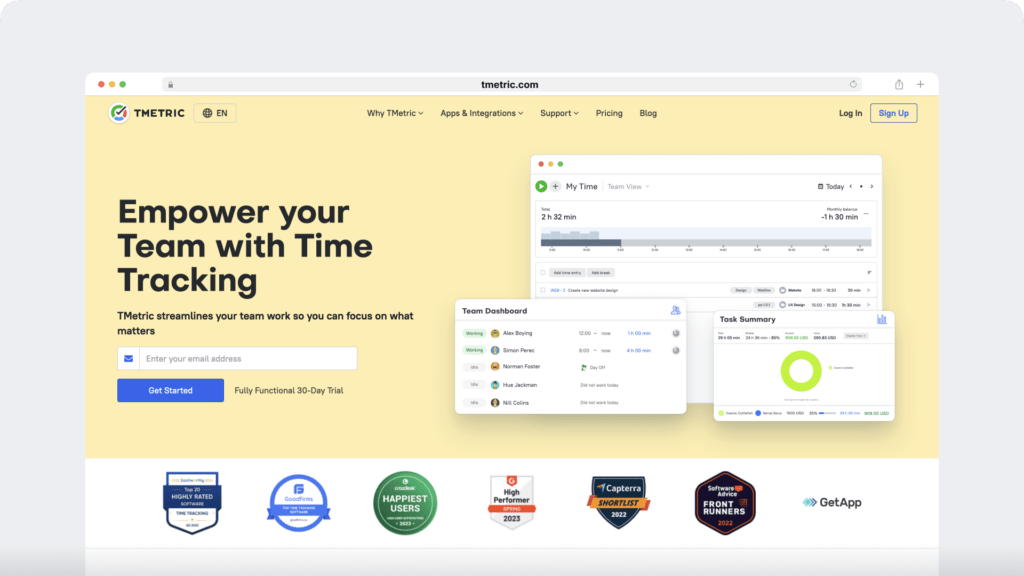
TMetric is a good and reliable alternative for TimeCamp users. Marked with an intuitive interface and wide functionality, it caters to the needs of freelancers and businesses equally well.
What you get in time tracking package:
- One-click retrieves of the data for payroll processing When you employ TMetric as a time tracking system, you practically get full-fledged project management and attendance system.
- Capturing activity level screenshots that help monitor employees’ performance in real-time
- Flexible system of time tracking permissions
- Offline tracking (work time will be recorded regardless of your online status)
- Flexible system to set rates and send invoices in a few clicks
- Time off and vacation leave tracking app
- Cross-platform availability on all devices (Windows, MacOs, Linux, Android, iOS)
- Rich integrations with 50+ services (including Jira, Redmine and Quickbooks for impeccable project management and timely payments).
Pros
- Accurate calculations on work time hassle-free
- Incorporating time tracking into the existing apps ecosystem
- Highly responsive customer support
- Valuable information on activity level for deeper understanding your productivity
Cons
- Browser extension is not available on Safari
- Somewhat limited scheduling options.
Pricing
TMetric is available on three pricing plans allowing a team of up 5 members to enjoy its time tracking features for free!
- Free: $0/month for up to 5 users to enable time tracking, reporting and web apps integrations.
- Professional: $5/month per user to get Free plan options + task management, invoicing and project budgeting.
- Business: $7/month per user to have Professional plan options + payroll for employees, time tracking permissions and integrations with Quickbooks, JIRA, and Redmine.
Customer ratings
- G2 Crowd – 4.5/5 (250+ reviews)
- Capterra – 4.5/ 5 (180+ reviews)
10. DeskTime
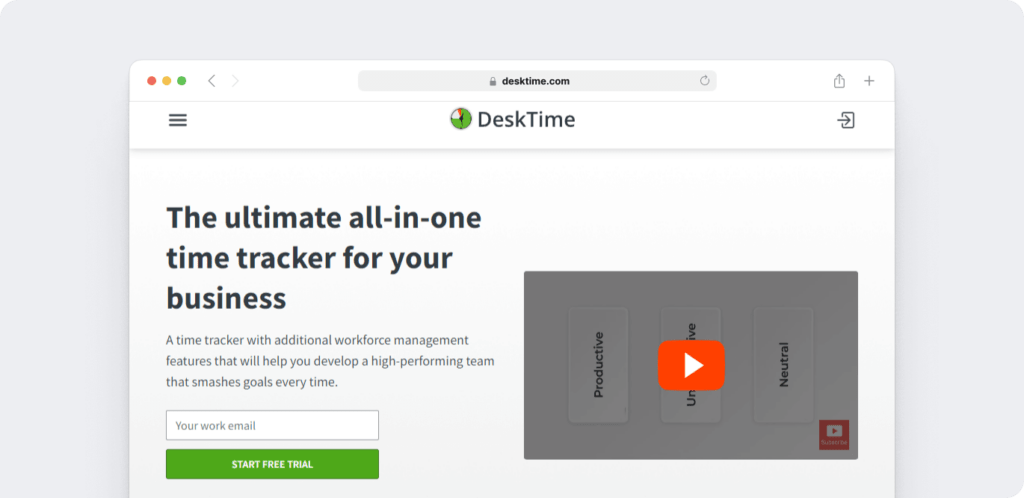
DeskTime is a fully automatic time tracking and productivity software for teams. With 14+ features and integrations with some of the most popular project management tools, DeskTime is one of the go-to alternatives to TimeCamp.
Key features
- Fully automatic – DeskTime starts and stops automatically as you turn on/of your computer
- Tracks URLs, programs, and apps and automatically categorizes them into productive or unproductive
- Project tracking and cost calculation options
- Detailed reports with numerous filtering options
Pros
- Desktop app for Windows, Mac, and Linux
- Employee-friendly features like Private time, Pomodoro timer, etc.
- Features for improved team collaboration – Team’s contacts, Absence Calendar, Shift Scheduling, etc.
Cons
- Limited free version
- Project tracking requires manual switching
Pricing
- Free: includes basic time tracking features
- Pro: starts at $5/user and can go as low as $4.58/user for larger teams if paid annually
- Premium:$7/user / month. Include everything in Pro, plus: Screenshots,Absence calendar
- Enterprise:$14/user / month.Include everything in Premium, plus: VIP support, Personalized onboarding
Customer ratings
- G2: 4.5/5 (270+ reviews)
- Capterra: 4.6 /5 (520+ reviews)
11. Timeneye
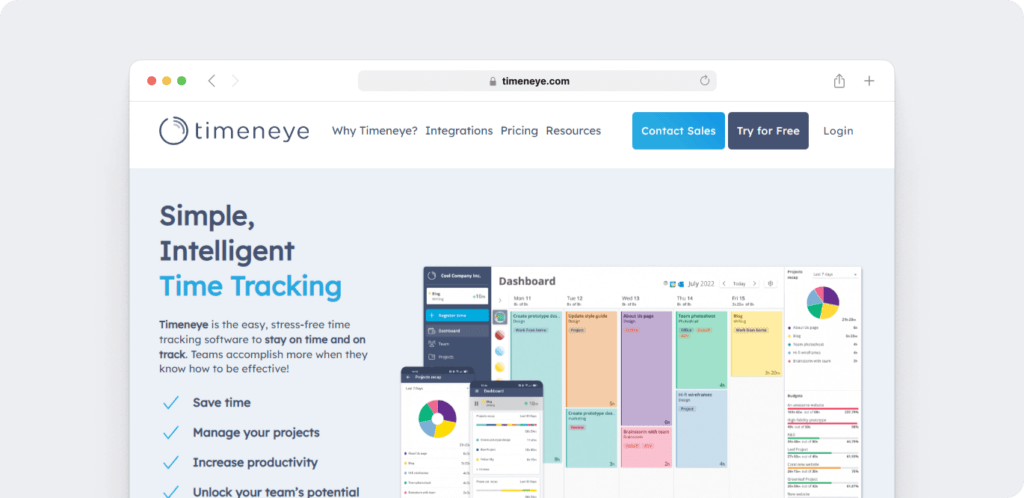
Timeneye is an easy time tracking tool for small-medium businesses and freelancers. It’s designed to track time for projects – every time entry has to be associated with a project and a phase.
Users can track time by simply clicking a button to start a timer, while managers and admins can monitor the work with pie chart recaps, reports, and weekly email summaries. Reports can be exported to PDF and CSV, and can be regularly scheduled and sent to the admins’ email.
Every project has a dedicated “Status” view to monitor the total hours tracked, hourly budgets, billable time, and member costs.
Key features:
- Calendar-style dashboard
- Billable hours management
- Browser extension for Chrome and Firefox
- iOS and Android apps for tracking time on the go
- Natively built integrations with Asana, Basecamp, ClickUp
- Time tracking for Google Calendar and Outlook Calendar events
Pros:
- Easy to use
- Visual colorful interface
- Billable hours can be exported for invoicing purposes
- Seamless integrations with other services.
Cons:
- Possibility to add the start and end time of a time entry only available on Beta.
Pricing:
- Pro:$6per user per month, billed yearly
- Enterprise:Contact Timeneye sales team
Customer ratings
- G2: 4.5/5 (20+ reviews)
- Capterra: 4.8 /5 (120+ reviews)
Conclusion
Choosing a time tracking tool doesn’t have to be very complicated.
With the right tool, it becomes incredibly easy to track what your employees are doing while monitoring their productivity.
While each of these tools is good, Time Doctor leads the pack with its powerful, advanced time tracking and productivity features. So why not sign up for a free 14-day trial and try it out yourself?


